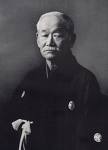

|
Judo History
|
|
Judo, meaning "gentle way", is a modern Japanese martial art and combat sport, that was developed in Japan by Prof. Jigoro Kano in the late nineteenth century. Kano, having a background in a number of ancient Jujitsu arts, pulled together the best of the throws and grappling techniques, added some of his own, and removed more dangerous foot and hand strikes. This produced a structured art that could be practiced safely as a competitive sport . The dangerous techniques were not forgotton though and are practised by higher grades in the form of Kata. Jigoro Kano saw Judo as a means to develop the mind, body and character of a person. To describe this he developed Seiryoku Zen'yo (minimum effort for maximum efficiency) and Jita Kyoei (mutual welfare). In 1882, Kano opened a dojo, which he named the Kodokan and started to train students. The dojo was a small room with a mat area consisting of 12 mats (12ft. x 18ft.), within the Eisohoji Zen Temple in Tokyo. The popularity of the Kodokan grew in size and soon had to move. Todays Kodokan contains 500 mats and has over 1 million visitors a year from all over the world. Judo was introduced in Britain in 1912, and in 1918 the first European judo club, the Budokwai, was founded by Gunji Koizumi, who was sent by Kano to spread the word of judo and develop its popularity in London and the UK. The Budokwai is still running today. There are different styles of Judo. With its inclusion in the Olympics in 1964, judo has drifted towards a contest style practice with medals being the main focus. In clubs where this style is taught, practice is focused mainly on randori and shia. Other schools focus on technique and tradition. They favour repetitive movements to make them instinctive, and the development of speed through practice with little resistance. Such clubs usually also teach kata as a form of technique development. |